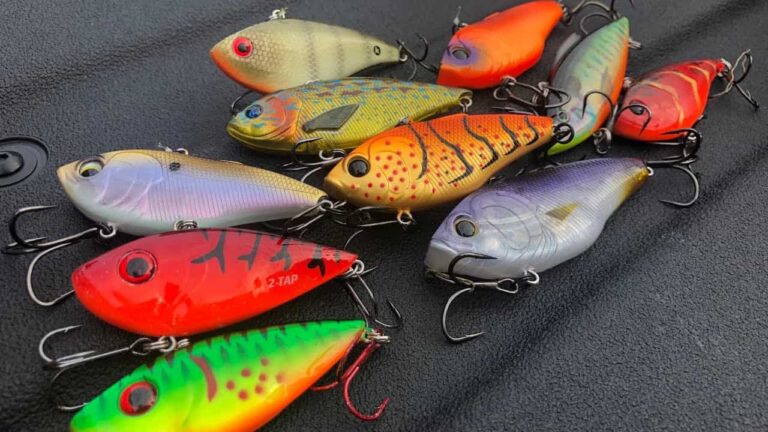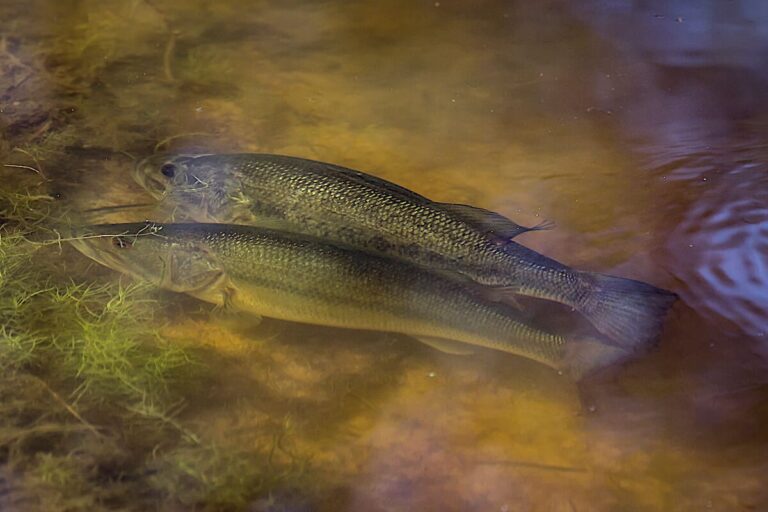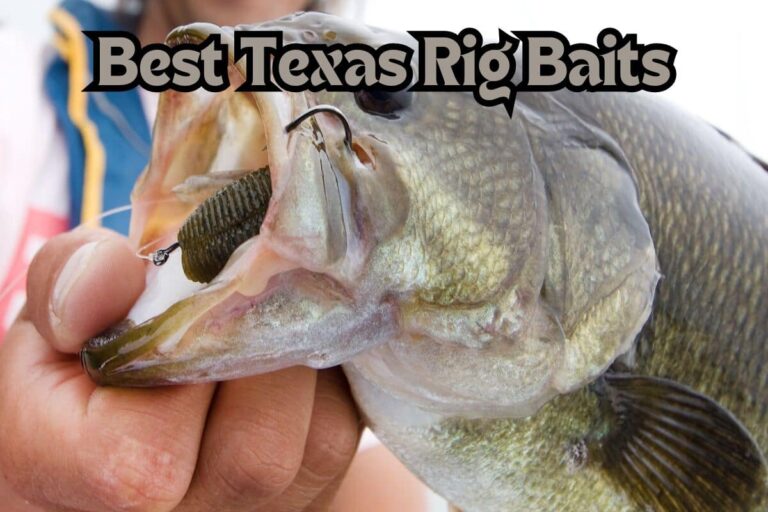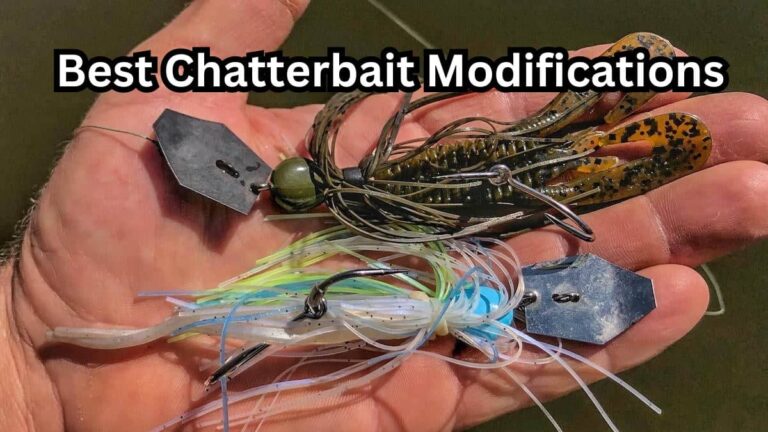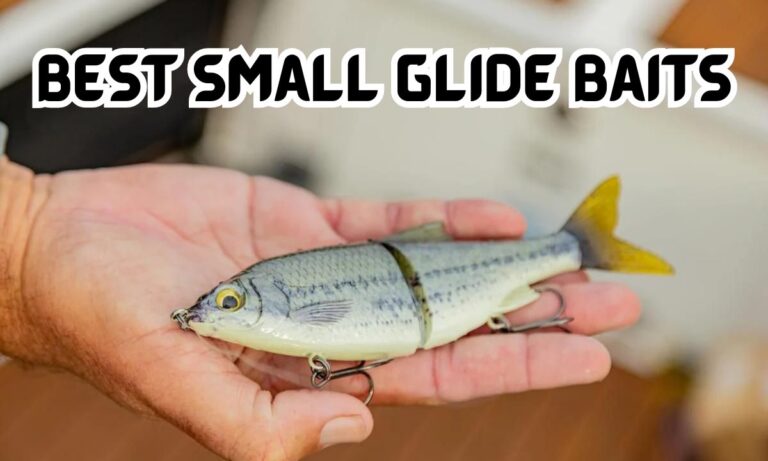Pond Bass Fishing Before, During, and After a Cold Front
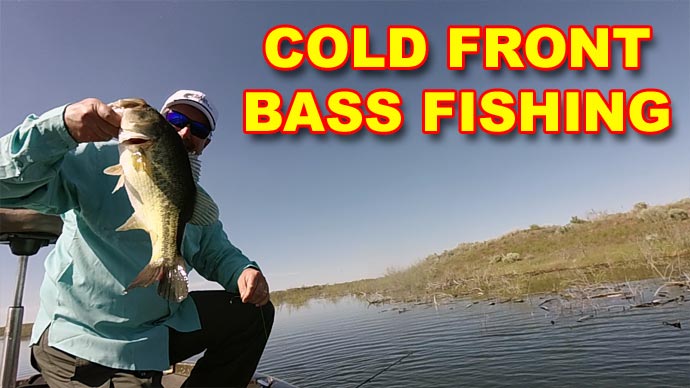
Cold fronts are a bit of an unknown for many bass fisherman. It seems like very few people actually know what effects cold fronts have on bass and other fish.
Cold fronts have a huge impact of bass fishing, especially when it comes to pond fishing.
So how do you approach pond bass fishing before, during, and after a cold front rolls through?
What Happens to Ponds and Fish in a Cold Front?
Before learning how to fish cold fronts, it is very important to understand how cold fronts effect ponds and fish.
Water Gets Colder
First and foremost, a cold front will make the water a bit colder. This is quite obvious, but should not be overlooked.
Even one cold front can drop the water temperature of a small pond by 2-4 degrees.
This may not seem like a huge difference, but it has a huge impact on fish behavior.
Fish do not know how long this front is going to last. For all they know, the cold front could last a very long time, and the water could continue to drop for weeks.
So fish will do one of two things during a cold front.
1. They will find and stick to structure and cover like glue. Bass will hold really tightly to structure and hunker down until the front is over.
It is very unlikely that they will swim more than a few feet from the cover throughout the entire front.
2. Fish will move out to the first depth change or drop off. Lots of fish will head out to deeper water during these cold fronts to stay warm and protected.
But it isn’t the winter season, so fish aren’t going to go all the way out to the deepest water.
The will only swim out to the first drop off and hunker down at that level.
They will also hold very tightly to the bottom and not rise much in the water column.
Barometric Pressure Drops and then Rises
The barometric pressure plays a large roll in activity and behavior of fish all year round.
Barometric pressure is one way that nature warns fish about an upcoming cold front.
In the days before a cold front begins, the barometric pressure will steadily drop.
This pressure will bottom out during the cold front, and then rise back up to a peak once the cold front has ended.
Check today’s barometric pressure
What is Barometric Pressure?
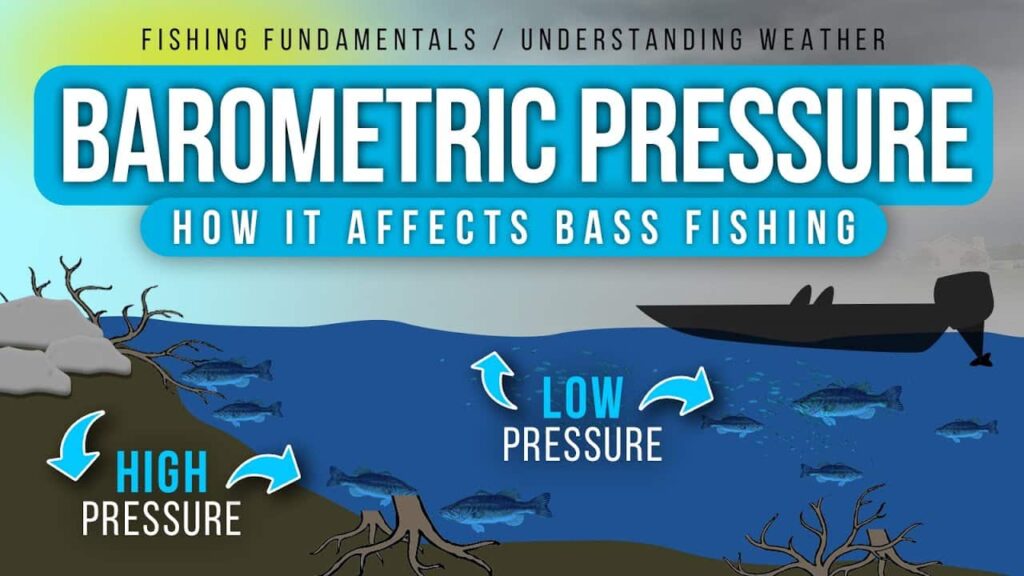
The barometric pressure is essentially how much weight that the pressure of the atmosphere is pushing down on the earth’s surface.
The barometric pressure is constantly changing and going up and down. Now, humans are not very adept at feeling and perceiving these changes in pressure.
But most animals and fish are very good at detecting these changes. A large drop in pressure means that a cold front and, or storm is coming.
This does a couple things to fish. Firstly, the drop in pressure means that there is less weight pushing down on fish.
So they will rise up in the water column and get closer to the surface.
The pressure drop will also give fish more energy and tell them they need to eat in preparation for the harsh conditions ahead.
As the front passes and the pressure rises back up, fish will fall back down in the water column and become more sluggish and less active.
So as a general rule, fishing is best before a cold front, when the barometric pressure is dropping.
And fishing is the worst after a cold front, when the barometric pressure rises back up.
Do Cold Fronts Slow Fishing Down?
As we just discussed, cold fronts both speed fishing up, and slow fishing down.
In the days right before the cold front, fishing will speed up and become very good.
Fish are very active, aggressive, and hungry. Fishing is amazing leading up to a cold front.
But once the cold front passes, fishing will slow down. The fish are sluggish, low in the water column, and feel extra weight and stress on their bodies.
Is Fishing Good Before a Cold Front?

Yes, because of the fish’s increased energy, rise in metabolism, and rise in the water column, fishing is very good before a cold front.
I have found that this is especially noticeable in ponds. I believe this is because since ponds are much smaller, all weather conditions effect them more.
If fish rise even a small bit in the water of a small, shallow pond, that could shift them from the very bottom all the way to the top.
Fishing before a cold front is one of the best times to catch bass.
How to Pond Bass Fish Before a Cold Front
Fish are tend to be very aggressive and active before a cold front. Power fishing is the name of the game for pre-cold front bass fishing.
I fish bigger, faster, louder, and flashier lures. You really want to try to get some reaction strikes during this short time period.
I still try to keep my lure colors on the natural side though. If a cold front is about to roll in, it most likely hasn’t rained in a little while.
So the water will be fairly clear. The clearer the water, the more natural colors you should be using.
Best Lures to Use Before a Cold Front
- Buzzbait: Top waters work great for these aggressive bass that are high in the water column. And the loud and annoying splashing buzzbait works extremely well.
- Walking Baits: Walking baits are another great top water. The side to side darting of a walking bait works very well for aggressive bass, especially if they are feeding on shad.
- Spinnerbait: The flash and vibration of spinnerbaits catch bass in all conditions. I will use a double willow leaf spinnerbait before a cold front because it can be fished very fast without rolling over or rising to the surface too quickly.
- Square Bill Crankbait: These will be fished a bit slower than the above lures, but the wide and obnoxious wobble of a square bill drives bass crazy.
Is Fishing Good During a Cold Front?
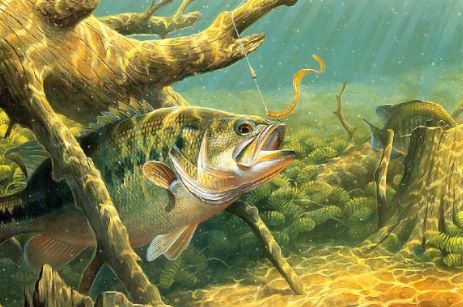
Fishing during a cold front is typically not very good. Like I explained earlier, fish will either cold very tightly to cover, or hangout on the bottom of the first drop off.
The hardest part for me is having the patience to pick apart these areas. Bass don’t really eat much because they just ate a lot in preparation for the front.
But you still can catch fish during a cold front.
How to Pond Bass Fish During a Cold Front
Look at the bright side. You know where the bass are. They are either on the structure or on the drop off.
Once you have identified these areas, finesse fishing very slowly is your best bet.
Bass aren’t going to chase after prey, so you need to fish slow.
And bass really aren’t that hungry, so you need enticing finesse techniques that will persuade them into biting.
Best Lures to Use During a Cold Front
- Drop Shot: The drop shot is my favorite finesse technique. It puts a realistic soft plastic right in front of the bass’s face. Making it hard for even finicky bass to not bite.
- Shaky Head: Shaking a floating worm on the drop off ledge will pick off lots of bass.
- Jig: This is for the bass that are holding tightly to cover. Flip a jig into wood and docks.
- Weedless Senko: I also use this setup for fishing heavy cover. The slow fall and flutter gets tons of bites from bass holding to cover.
Is Fishing Good After a Cold Front?
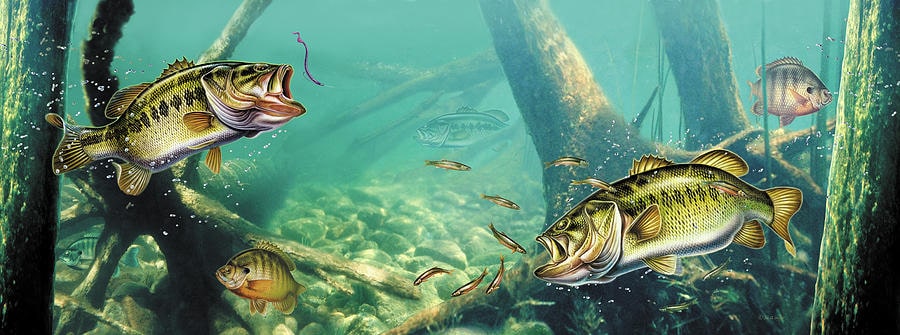
Fishing after a cold front is usually not good. The temperatures are warm again, the sky is blue, and there is next to no wind.
Seems like perfect conditions right?
Well not exactly. The barometric pressure is going to b very high directly after a cold front.
This pushes bass down and lowers their metabolism and aggression. And wind is actually very good for fishing.
Unless you are fishing in the winter, you always want to fish in the wind.
What Happens to Bass After a Cold Front?
This is the most difficult cold front phase to fish.
The bass are spreading out again, so you don’t know exactly where they are, but they are not super aggressive because of the high barometric pressure and lack of wind or cloud cover.
They also stay low in the water column because of the high pressure pushing down on them.
These bass slowly become more active and hungry in the days after a cold front.
2-3 days after the front passes, bass will return to their normal habits and activity levels.
How to Pond Bass Fish After a Cold Front
To effectively catch bass after a cold front, you need to be able to fish a bit deeper, cover water, and have enough sound, flash, or vibration for the bass to find your bait.
The water is most likely a bit muddier because of the cold front storms.
Best Lures to Use After a Cold Front
- Chatterbait: Chatterbaits can be fished at all depths and put off tons of vibration. With a variety of trailer options and skirt colors, you can fish all water visibilities effectively.
- Spinnerbait: Bladed and skirted baits are my go-to lures when fishing after a cold front. This spinnerbait will be a single Colorado blade spinnerbait so that I can fish it slower and put off more vibration.
- Jerkbait: A suspending jerkbait can be fished as slow as you want, is a realistic presentaion for finicky bass, and with bead or rattles, bass can easily hone in on it even in darker water.
Is It Better to Fish Before or After a Cold Front?
It is definitely better to fish before a cold front. This is simply because bass are very active and aggressive before the cold front, and very sluggish and finicky after the cold front.
Spring Cold Front Fishing
Every spring pre-spawn phase has a couple cold fronts that roll through. Because the water is still cold, this can really throw a wrench in your fishing strategy.
The days before the front will still be very good and make bass aggressive. But during and after the cold front will be quite tuff.
Instead of moving from real shallow water out to the first drop off, these bass are moving from the first drop off back out to the middle of the pond.
During and right after a spring cold front, I will go back to my winter pond bass fishing strategies.
It can be discouraging, but keep in mind that the effects of the front will pass quickly and just trust the process.
Also Read: Best Lures for Pond Bass in Spring
Summer Cold Front Fishing
Summer cold fronts tend to be a bit different from spring and fall. Summer cold front are usually very mild, but very often.
There might be 5-10 cold fronts throughout the summer, but each one was only a 10-20 degree drop in temperature.
And when the average temperatures are very high, this isn’t as big of a difference.
These more mild cold fronts don’t have as big of an effect on summer ponds.
Since the water temperatures are very high (even during and after the cold fronts), bass’s metabolism is also very high.
So even in a cold front, bass still need to eat a lot and are still pretty active.
Fall Cold Front Fishing
Fall cold fronts are very impactful. Temperatures are already on a decline, vegetation is dying out, and fish are preparing for winter.
The impacts of cold fronts will be elevated during the fall. Fishing will be incredible before the cold front, and very difficult during and shortly after the front.
However, bass will bounce back faster after the cold front because they know that they still have lots to do before winter fully sets in.
They can’t waste time hunkering down. So bass are usually only inactive for a 2-3 days at a time during the cold front.
You can slow down your fishing for a couple days, but then get right back to throwing traditional fall bass lures.
Winter Cold Front Fishing
Winter cold fronts are brutal. To be honest, I never really fish them because it is not worth it in my eyes.
Fishing does get a bit better before the front, but during and after is very bad fishing.
Winter bass are already quite inactive and not eating much. So when a cold front rolls in, they pretty much don’t move or eat anything.
If you are winter fishing from the bank, there isn’t much you can do to catch these bass.
My best advice is save up the energy and get out there a few days after the cold front has passed.
Reeling this In
Pond bass fishing in a cold front is a double edged sword. Fishing is really good before the front, but not so good after.
As long as you are using the right strategies, you can catch bass before, during, and after a cold front.
Now that you know how cold fronts effect bass and how to catch bass in each phase of the cold front, don’t be intimidated when the forecast shows a drop in temperature coming up.
Just implement the correct fishing strategies, and you will have no problem catching bass.

